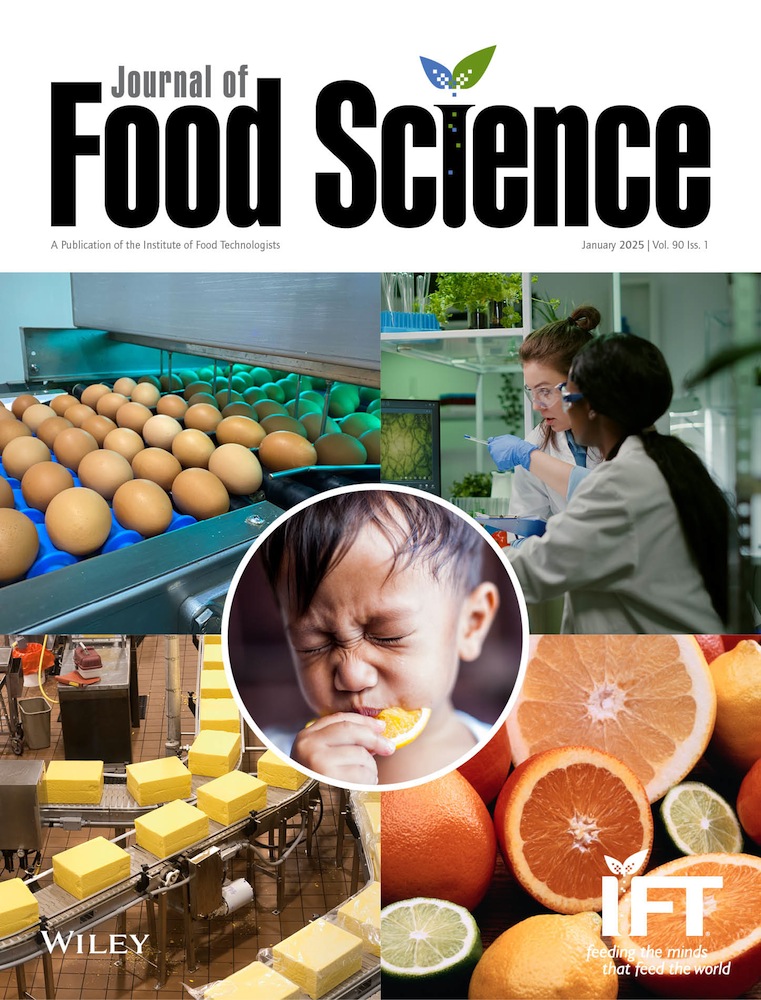Ver ítem
- xmlui.general.dspace_homeCentros e Institutos de InvestigaciónCIA. Centro de Investigaciones de AgroindustriaInstituto de Tecnología de AlimentosArtículos científicosxmlui.ArtifactBrowser.ItemViewer.trail
- Inicio
- Centros e Institutos de Investigación
- CIA. Centro de Investigaciones de Agroindustria
- Instituto de Tecnología de Alimentos
- Artículos científicos
- Ver ítem
Thermal-assisted pressure processing: effects of marination, temperature, and pressure level on physicochemical, color and textural parameters of Superficial pectoralis beef muscle
Resumen
This study aimed to evaluate the effects of salt addition and different thermal-assisted pressure processing (TAPP) conditions (temperature and pressure levels) on technological, chromatic, and textural parameters and lipid oxidation of Superficial pectoralis beef muscle. A factorial design with three factors was applied: KCl/NaCl marination (marinated samples MS; non-marinated samples, NMS), temperature during high-pressure processing (50, 70°C), and
[ver mas...]
This study aimed to evaluate the effects of salt addition and different thermal-assisted pressure processing (TAPP) conditions (temperature and pressure levels) on technological, chromatic, and textural parameters and lipid oxidation of Superficial pectoralis beef muscle. A factorial design with three factors was applied: KCl/NaCl marination (marinated samples MS; non-marinated samples, NMS), temperature during high-pressure processing (50, 70°C), and pressure level (0.1, 200, and 300 MPa). All factors affect the water-holding capacity of beef, which is important to ensure both high yields and optimal tenderness and juiciness in the final product. MS treated at 50°C had the highest yield values, regardless of applied pressure level. TAPP modified the color parameter values of raw samples, resulting in brighter and less reddish. After cooking, color differences remained, indicating that this process did not fully reverse the changes induced by TAPP treatments. MS had lower shear force values than NMS. The presence of salts slightly diminished shear force values. A similar texture profile was obtained for NMS treated at 70°C and 300 MPa and MS treated at 50°C and 200 MPa. NMS and MS treated at 70°C and 0.1 MPa had the highest thiobarbituric acid reactive substance values. Based on the results, marinated samples treated at 200 MPa and 50°C were selected for treatment. TAPP could be an innovative technology for the development of value-added beef products with assured texture.
[Cerrar]
Este estudio tuvo como objetivo evaluar los efectos de la adición de sal y diferentes condiciones de procesamiento de presión térmica asistida (TAPP) (niveles de temperatura y presión) sobre los parámetros tecnológicos, cromáticos y texturales y la oxidación de lípidos del músculo pectoral superficial de res. Se aplicó un diseño factorial con tres factores: marinado KCl/NaCl (muestras marinadas MS; muestras no marinadas, NMS), temperatura durante el
[ver mas...]
Este estudio tuvo como objetivo evaluar los efectos de la adición de sal y diferentes condiciones de procesamiento de presión térmica asistida (TAPP) (niveles de temperatura y presión) sobre los parámetros tecnológicos, cromáticos y texturales y la oxidación de lípidos del músculo pectoral superficial de res. Se aplicó un diseño factorial con tres factores: marinado KCl/NaCl (muestras marinadas MS; muestras no marinadas, NMS), temperatura durante el procesamiento a alta presión (50, 70°C) y nivel de presión (0.1, 200 y 300 MPa). Todos los factores afectan la capacidad de retención de agua de la carne, lo cual es importante para garantizar altos rendimientos y una ternura y jugosidad óptimas en el producto final. MS tratado a 50°C tuvo los valores de rendimiento más altos, independientemente del nivel de presión aplicado. TAPP modificó los valores de los parámetros de color de las muestras sin procesar, lo que resultó en unas muestras más brillantes y menos rojizas. Después de la cocción, persistieron diferencias de color, lo que indica que este proceso no revirtió completamente los cambios inducidos por los tratamientos TAPP. MS tuvo valores de fuerza cortante más bajos que NMS. La presencia de sales disminuyó ligeramente los valores de la fuerza de corte. Se obtuvo un perfil de textura similar para NMS tratado a 70°C y 300 MPa y MS tratado a 50°C y 200 MPa. NMS y MS tratados a 70°C y 0,1 MPa tuvieron los valores más altos de sustancia reactiva al ácido tiobarbitúrico. Con base en los resultados, se seleccionaron para el tratamiento muestras marinadas tratadas a 200 MPa y 50°C. TAPP podría ser una tecnología innovadora para el desarrollo de productos bovinos con valor agregado y textura asegurada.
[Cerrar]

Autor
Silva Paz, Reynaldo Justino;
Sancho, Ana Maria;
Vaudagna, Sergio Ramon;
Szerman, Natalia;
Fuente
Jornal of Food Science 90 (1) : e17627 (January 2025)
Fecha
2024-12
Editorial
Wiley
ISSN
1750-3841 (online)
0022-1147 (print)
0022-1147 (print)
Documentos Relacionados
Formato
pdf
Tipo de documento
artículo
Proyectos
(ver más)
INTA/2019-PD-E7-I153-001, Estrategias tecnológicas innovadoras para la transformación y preservación de alimentos
INTA/2023-PE-L04-I088, Innovaciones tecnológicas aplicadas a la sostenibilidad en agroindustria
Palabras Claves
Derechos de acceso
Restringido
 Excepto donde se diga explicitamente, este item se publica bajo la siguiente descripción: Creative Commons Attribution-NonCommercial-ShareAlike 2.5 Unported (CC BY-NC-SA 2.5)
Excepto donde se diga explicitamente, este item se publica bajo la siguiente descripción: Creative Commons Attribution-NonCommercial-ShareAlike 2.5 Unported (CC BY-NC-SA 2.5)


